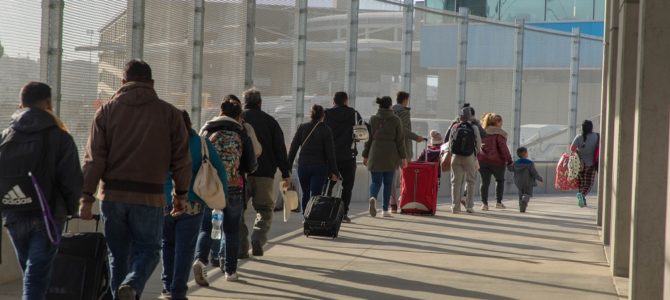
The Department of Homeland Security announced this week it will begin accepting applications for the Deferred Action for Childhood Arrivals (DACA) program after a federal judge ordered the Trump administration to reinstate the program earlier this month.
The ruling briefly put DACA back in the headlines, with most news outlets framing the judge’s order as a defeat for the departing Trump administration and a victory for Democrats and the “Dreamers.” But the media’s preferred narrative ignores the truth about DACA, an Obama-era program created by bureaucratic fiat in direct violation of the Constitution’s separation of powers.
Democrats and the media like to emphasize all the good DACA has done. They point out that the program’s recipients, mostly young people who were brought to the United States illegally before age 18, have earned degrees, begun careers, paid taxes, married, and had some 200,000 children who are U.S. citizens.
But none of that has anything to do with why President Trump and many Republicans want to end the program. Their purpose is not to punish DACA recipients but to pressure Congress to do its job and reform a dysfunctional and sclerotic immigration system that created this mess in the first place.
The Trump administration’s approach from the beginning was that DACA, however noble its aims, was not legal, and that only an act of Congress—an actual law—could shield certain people from deportation or create a new program authorizing work permits for hundreds of thousands of illegal immigrants, as DACA purported to do.
Trump’s widely criticized efforts to “end” the program were actually meant to prod Congress into action. Recall that in September 2017, the Trump administration announced a plan to phase out DACA, and then deferred the phase-out for six months to give Congress time to come up with a permanent solution.
Lawmakers balked, but Trump gave them another chance during the government shutdown in January 2019, when he proposed a three-year extension of DACA along with an extension of a refugee program in exchange for $5.7 billion in funding for a border wall. The idea, again, was to extend DACA to allow Congress time to devise a permanent solution for DACA recipients, perhaps as part of a broader overhaul of the immigration system. Trump and his top advisors were clear about this at the time.
But congressional Democrats rejected the president’s offer even before it was announced. House Speaker Nancy Pelosi called it a “non-starter” and Senate Minority Leader Chuck Schumer panned it as “hostage taking.”
DACA Isn’t A Law, It’s a Memo
You might think that a president using his executive powers to put pressure on Congress to take legislative action is part of the normal push and pull of our constitutional system. But Democrats seem to think executive branch programs created by Democratic administrations should have the same status as laws passed by Congress.
That is not how it works. Programs like DACA, which effectively granted amnesty to hundreds of thousands of illegal immigrants, amount to lawmaking and ought to be passed by lawmakers, not decreed by presidents who can’t get their preferred policies through a divided Congress.
After all, DACA is not law—not even an executive order. It is a memo. The program was created by the issuance of an executive memorandum in June 2012 from then-Secretary of Homeland Security Janet Napolitano to the heads of U.S. Citizenship and Immigration Services (USCIS), Customs and Border Protection (CBP), and Immigration and Customs Enforcement (ICE). The memo directed these agencies to exercise “prosecutorial discretion” on behalf of anyone who met certain requirements.
That is, under the guise of “discretion,” Obama managed both to ignore existing federal immigration law—thereby betraying his oath of office to “take Care that the Laws be faithfully executed”—and effectively create new law by administrative decree.
Even the language used to talk about the program betrays its unconstitutional origins. Democrats and the media call DACA recipients “Dreamers,” a reference to the DREAM Act, a bill that was first introduced in 2001 but never gained enough support in Congress to pass. What Democrats couldn’t do by law, they eventually managed to do by executive decree.
The Supreme Court Is Partly To Blame Here
So far, the U.S. Supreme Court has let them do it. In June, the court issued a narrowly tailored 5-4 ruling that the Trump administration could not dismantle DACA because DHS’s plan to do so did not comply with the Administrative Procedures Act (APA).
Writing for the majority, Chief Justice John Roberts argued the court was not weighing in on whether DACA’s creation or recission were “sound policies,” only that the decision to end the program didn’t comply with “the procedural requirements in the law that insist on ‘a reasoned explanation for its action.’” As a result, wrote Roberts, Trump’s attempt to end DACA was “arbitrary and capricious.”
One might reply, as Justice Clarence Thomas did in his dissent, that the creation of DACA was clearly an abuse of power by the executive branch, which arrogated to itself legislative authority to change the law. Roberts and the majority ruled as they did, wrote Thomas, only to “to avoid a politically controversial but legally correct decision.”
Thomas went on to argue that the Trump administration need not have even provided a reason for ending a program that had no legal authority to begin with: “Nothing in the APA suggests that DHS was required to spill any ink justifying the rescission of an invalid legislative rule, let alone that it was required to provide policy justifications beyond acknowledging that the program was simply unlawful from the beginning.”
Thomas is right. The Trump administration was well within its rights to wind down DACA as part of a larger strategy to pressure congressional Democrats to compromise on an immigration deal. That Trump’s strategy failed means Democrats under a Biden administration will no doubt seek once again to change immigration law—not by a congressional vote, but by bureaucratic fiat.









